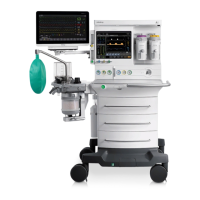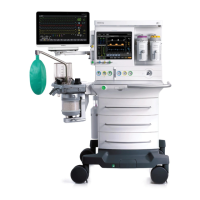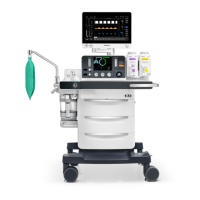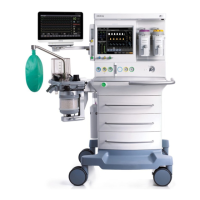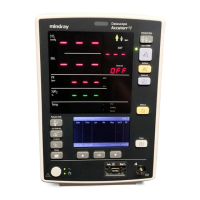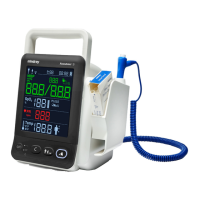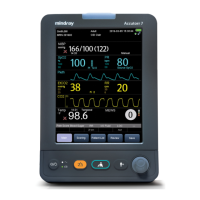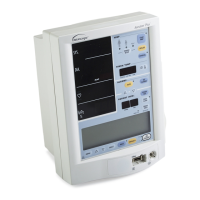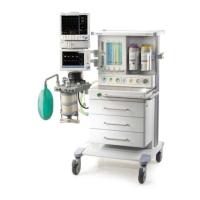Operator’s Manual of Anesthesia System 6 - 7
Operations Set Ventilation
When the system exits the standby mode and enters the Manual ventilation mode, if the [CO
2
Alarms] soft key is [On], the system will not enable the CO
2
and the CO
2
apnea alarms until three
continuous respiratory waves are monitored.
In the following two cases, the system will disable the CO
2
alarms or CO
2
apnea alarms for
30 seconds. After 30 seconds, the CO
2
and the CO
2
apnea alarms will be enabled even if no
respiratory wave has been monitored.
•If the [CO
2
Alarms] soft key is set to [On] from the [Off ] status
• Set the Auto/Manual switch from the Manual position to the Auto position
WARNING: Risk of inadequate monitoring. National standards require a minimum
monitoring with some basic alarm functions. The standard may not be
met if the CO
2
parameter alarms feature is disabled. Please disable the
CO
2
parameter alarms feature only after you check the standard.
6.6.3 Settings Before Starting the Automatic Ventilation Mode
1. Enter Standby mode.
2. Select the desired ventilation mode tab.
3. Set the desired ventilation parameters.
4. Select the [Set Mode] key (flashing green) on the right of the ventilation tab to confirm the
ventilation mode.
5. If in Standby, exit Standby by touching the Main Screen.
6. To begin automatic ventilation, set the Auto/Manual switch to the Auto position.
6.6.4 Volume Control Ventilation (VCV)
Volume Control Ventilation (VCV) mode is a fully automatic ventilation mode. In the VCV mode, each
time automatic ventilation starts, gas is delivered to the patient at a constant flow, which reaches the
preset Vt within the gas delivery time. To ensure a certain amount of Vt, the resulted airway pressure
(Paw) changes based on patient pulmonary compliance and airway resistance.
In the VCV mode, you need to set the Plimit to prevent harm to patients that may be caused by
excess airway pressure. Set Tpause to improve patient pulmonary gas distribution and PEEP to
prevent end-expiratory alveolar collapse and improve hypoxemia.
To ensure the set tidal volume gas delivery, the ventilator adjusts gas flow based on the measured
inspiratory volume, dynamically compensating for breathing system compliance and system leakage
and eliminating the effect of fresh gas flow as well. This is called tidal volume compensation.
To avoid an excessive amount of gas being delivery due to an incorrect compensation calculation, the
compensation calculation has two thresholds.
1) The calculated compliance of tube is limited to 5mL/cmH
2
O.
2) The volume for leakage compensation is limited to 0.5×VT setting value.
In the VCV mode, if tidal volume compensation fails, the system can continue to deliver gas in a stable
manner but cannot compensate for the effects of fresh gas flow and breathing system compliance losses.
In VCV and SIMV-VC modes, when inspiration pressure reaches Plimit, respectively, the inspiration
pressure is held.

